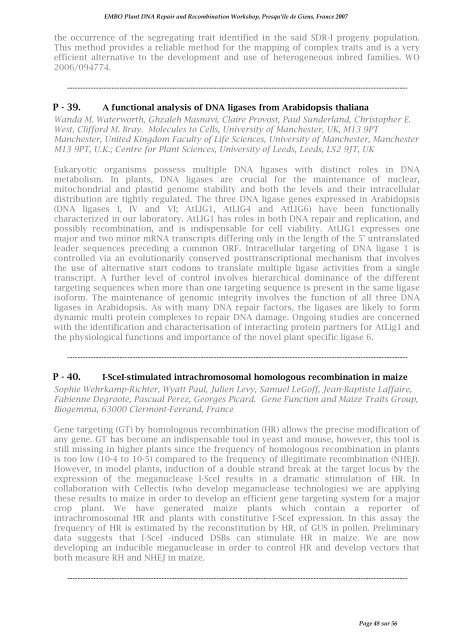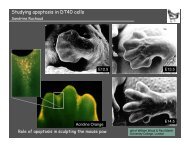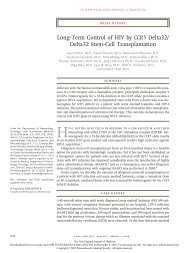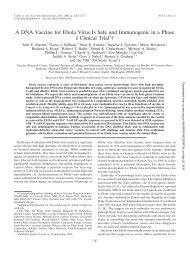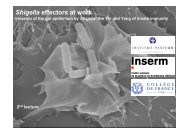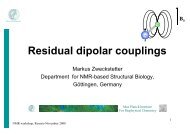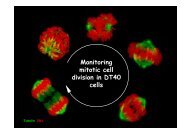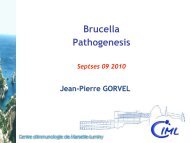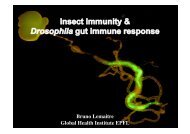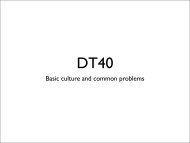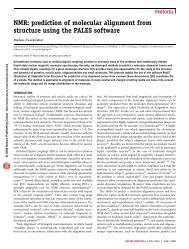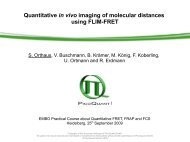pdf file - Events - EMBO
pdf file - Events - EMBO
pdf file - Events - EMBO
Create successful ePaper yourself
Turn your PDF publications into a flip-book with our unique Google optimized e-Paper software.
<strong>EMBO</strong> Plant DNA Repair and Recombination Workshop, Presqu'île de Giens, France 2007<br />
the occurrence of the segregating trait identified in the said SDR-I progeny population.<br />
This method provides a reliable method for the mapping of complex traits and is a very<br />
efficient alternative to the development and use of heterogeneous inbred families. WO<br />
2006/094774.<br />
----------------------------------------------------------------------------------------------------------------------------------<br />
P - 39. A functional analysis of DNA ligases from Arabidopsis thaliana<br />
Wanda M. Waterworth, Ghzaleh Masnavi, Claire Provost, Paul Sunderland, Christopher E.<br />
West, Clifford M. Bray. Molecules to Cells, University of Manchester, UK, M13 9PT<br />
Manchester, United Kingdom Faculty of Life Sciences, University of Manchester, Manchester<br />
M13 9PT, U.K.; Centre for Plant Sciences, University of Leeds, Leeds, LS2 9JT, UK<br />
Eukaryotic organisms possess multiple DNA ligases with distinct roles in DNA<br />
metabolism. In plants, DNA ligases are crucial for the maintenance of nuclear,<br />
mitochondrial and plastid genome stability and both the levels and their intracellular<br />
distribution are tightly regulated. The three DNA ligase genes expressed in Arabidopsis<br />
(DNA ligases I, IV and VI; AtLIG1, AtLIG4 and AtLIG6) have been functionally<br />
characterized in our laboratory. AtLIG1 has roles in both DNA repair and replication, and<br />
possibly recombination, and is indispensable for cell viability. AtLIG1 expresses one<br />
major and two minor mRNA transcripts differing only in the length of the 5’ untranslated<br />
leader sequences preceding a common ORF. Intracellular targeting of DNA ligase 1 is<br />
controlled via an evolutionarily conserved posttranscriptional mechanism that involves<br />
the use of alternative start codons to translate multiple ligase activities from a single<br />
transcript. A further level of control involves hierarchical dominance of the different<br />
targeting sequences when more than one targeting sequence is present in the same ligase<br />
isoform. The maintenance of genomic integrity involves the function of all three DNA<br />
ligases in Arabidopsis. As with many DNA repair factors, the ligases are likely to form<br />
dynamic multi protein complexes to repair DNA damage. Ongoing studies are concerned<br />
with the identification and characterisation of interacting protein partners for AtLig1 and<br />
the physiological functions and importance of the novel plant specific ligase 6.<br />
----------------------------------------------------------------------------------------------------------------------------------<br />
P - 40. I-SceI-stimulated intrachromosomal homologous recombination in maize<br />
Sophie Wehrkamp-Richter, Wyatt Paul, Julien Levy, Samuel LeGoff, Jean-Baptiste Laffaire,<br />
Fabienne Degroote, Pascual Perez, Georges Picard. Gene Function and Maize Traits Group,<br />
Biogemma, 63000 Clermont-Ferrand, France<br />
Gene targeting (GT) by homologous recombination (HR) allows the precise modification of<br />
any gene. GT has become an indispensable tool in yeast and mouse, however, this tool is<br />
still missing in higher plants since the frequency of homologous recombination in plants<br />
is too low (10-4 to 10-5) compared to the frequency of illegitimate recombination (NHEJ).<br />
However, in model plants, induction of a double strand break at the target locus by the<br />
expression of the meganuclease I-SceI results in a dramatic stimulation of HR. In<br />
collaboration with Cellectis (who develop meganuclease technologies) we are applying<br />
these results to maize in order to develop an efficient gene targeting system for a major<br />
crop plant. We have generated maize plants which contain a reporter of<br />
intrachromosomal HR and plants with constitutive I-SceI expression. In this assay the<br />
frequency of HR is estimated by the reconstitution by HR, of GUS in pollen. Preliminary<br />
data suggests that I-SceI -induced DSBs can stimulate HR in maize. We are now<br />
developing an inducible meganuclease in order to control HR and develop vectors that<br />
both measure RH and NHEJ in maize.<br />
----------------------------------------------------------------------------------------------------------------------------------<br />
Page 48 sur 56


